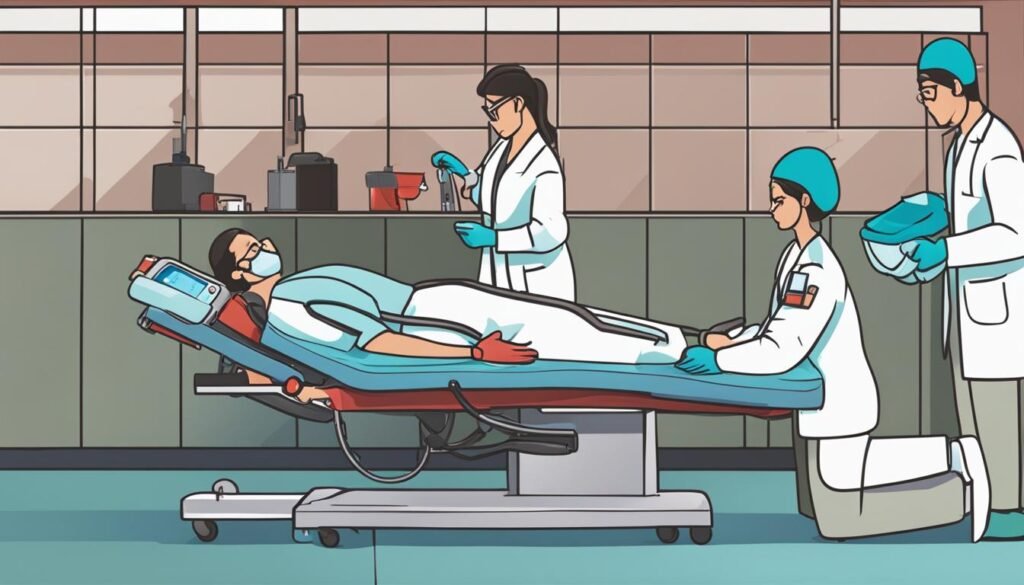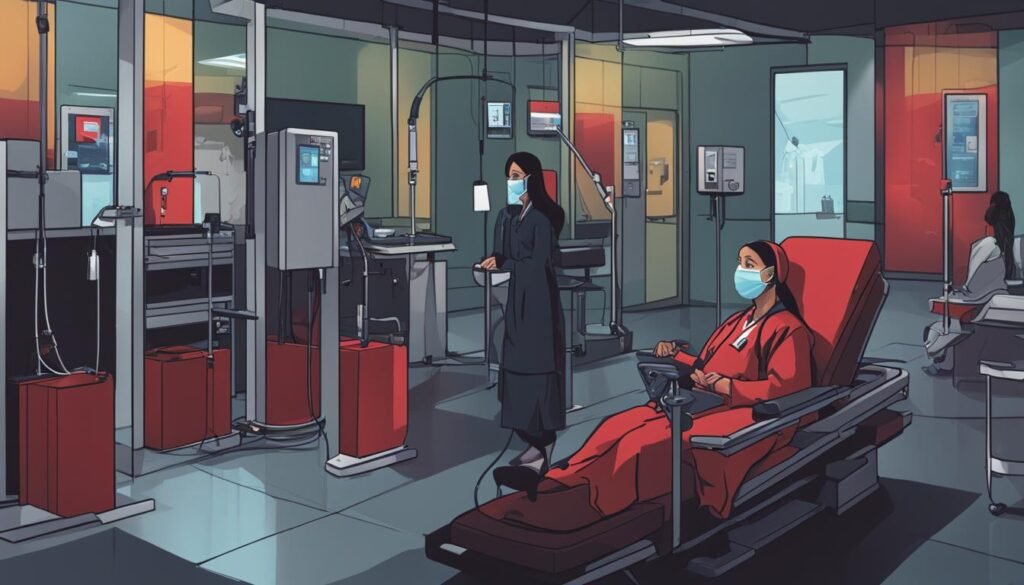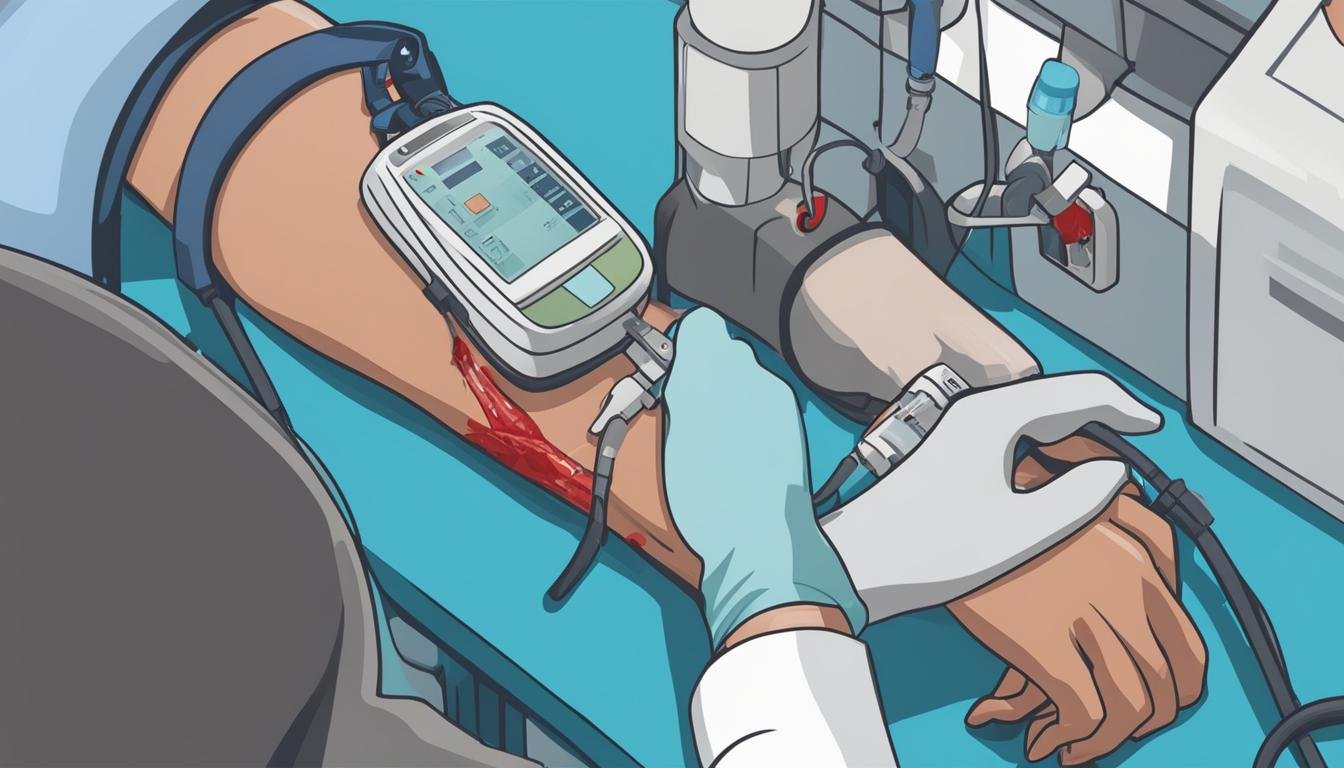Welcome to our article on the intriguing practice of elbow checks during plasma donation. If you’ve ever wondered why plasma donation centers thoroughly examine your elbows, you’ve come to the right place. In this section, we’ll delve into the reasons behind this procedure and shed light on the significance it holds in the blood donation process.
Donating plasma is a life-saving act that contributes to the creation of medical therapies used to treat a variety of conditions. However, the safety and well-being of both donors and recipients are of paramount importance. That’s why plasma donation centers take great care in screening donors and conducting elbow checks to ensure a smooth and secure donation process.
Key Takeaways:
- Elbow checks are conducted during plasma donation to locate suitable veins and ensure their health.
- Phlebotomists examine the elbows to avoid nerves, detect signs of IV drug use, and evaluate the impact of previous donations.
- Thorough elbow checks contribute to donor safety, lower infection risks, and ensure successful venipuncture.
- Plasma donation carries certain risks, but following guidelines can help minimize them.
- The careful assessment of the elbows provides reassurance to donors about their safety and comfort.
An Overview of Plasma Donation
Plasma donation is a vital process that plays a crucial role in saving lives and improving the health of patients. Unlike traditional blood donation, plasma donation focuses specifically on collecting the liquid portion of blood known as plasma. This plasma is then used to create lifesaving medical therapies for individuals suffering from various conditions, including immunodeficiencies, bleeding disorders, burn victims, shock and trauma patients, and organ transplant recipients.
Before becoming a plasma donor, it is important to understand the eligibility requirements. Plasma donation centers have strict criteria that potential donors must meet to ensure the safety and well-being of both the donor and the recipient. These requirements typically include age restrictions, weight limitations, and overall good health. Additionally, donors are required to undergo thorough medical history reviews, physical examinations, and screening for infectious diseases to ensure the quality and safety of the donated plasma.
By donating plasma, individuals have the opportunity to make a positive impact on the lives of others. The plasma collected goes through a rigorous screening and processing process to ensure its safety and effectiveness in medical treatments. Regular donors are screened before every donation to ensure their continued eligibility and to maintain the highest standards of safety throughout the plasma donation process.
The Purpose of Elbow Checks in Plasma Donation
During the plasma donation process, thorough examination of the elbows plays a crucial role in ensuring a successful and safe procedure. The primary purpose of elbow checks is to find suitable veins for venipuncture and ensure their health. This helps to facilitate the collection of plasma efficiently and without complications.
One of the key objectives of elbow checks is to identify veins that are appropriate for the donation process. Phlebotomists carefully examine the size, position, and condition of the veins in the antecubital area of the arms, including the basilic vein, cephalic vein, and median cubital vein. Ensuring the veins are healthy is essential to minimize the risk of adverse reactions and ensure a smooth donation experience for the donor.
Furthermore, elbow checks also involve examining the skin around the elbows for any indications of potential skin conditions or signs of intravenous (IV) drug use. Detecting these conditions is important as it helps to ensure the safety of both the donor and the recipient of the plasma. Additionally, phlebotomists take into account the impact of previous donations on the veins during the elbow check, as repeated donations can affect the health and resilience of the veins.
The Process of Elbow Checks
During the plasma donation process, elbow checks play a vital role in ensuring the safety of both donors and recipients. This assessment process involves several important steps that help phlebotomists identify suitable veins and ensure the overall health of the donor’s arms.
First, the donor is asked to expose their elbows by rolling up their sleeves. This step allows the phlebotomist to have a clear view of the antecubital area, where the veins are located. To ensure a clean and sterile environment, the area around the elbows is then carefully cleaned with an antibacterial sanitizing agent.
Once the elbows are exposed and cleaned, a tourniquet is tied around the upper arm. This increases the venous pressure, making the veins more visible and easier to access. The phlebotomist then visually inspects the elbows, looking for the best vein and site for venipuncture. In addition to visual inspection, the phlebotomist also palpates the soft tissue to evaluate the resilience of the veins.
Finally, the skin around the elbows is thoroughly checked for any rashes, wounds, or signs of IV drug use. This step ensures that the donor’s arms are in optimal condition for the plasma donation process. By following this rigorous elbow assessment process, plasma donation centers uphold high standards of safety and care for their donors.

Summary:
- The process of elbow checks during plasma donation involves several steps to ensure donor safety and vein suitability.
- Donors are asked to expose their elbows, which are then cleaned with an antibacterial agent.
- A tourniquet is tied to increase venous pressure, making the veins more visible.
- The phlebotomist visually inspects the elbows, palpates the soft tissue, and checks the skin for any abnormalities.
- This thorough assessment process helps maintain a safe and comfortable plasma donation experience for donors.
The Importance of Elbow Checks in Plasma Donation
Elbow checks in plasma donation play a vital role in ensuring donor safety throughout the process. These checks are essential for several reasons, including lowering the risk of infection, preventing nerve injury, ensuring successful draws, allowing modifications if needed, and providing reassurance to donors.
By carefully examining the elbows, phlebotomists can identify suitable veins for venipuncture. This is crucial for successful plasma donation as it ensures proper blood flow and minimizes discomfort for the donor. Additionally, elbow checks help to lower the risk of infection by avoiding compromised skin and veins, thereby maintaining a safe donation environment.
Furthermore, the thorough inspection of the elbows during the screening process helps to prevent nerve injury. Accidental contact with nerves, arteries, or tendons can lead to complications and discomfort for the donor. Through elbow checks, phlebotomists can avoid these sensitive areas and ensure a safe donation process.
Lastly, elbow checks allow for modifications if any concerns are found. If the phlebotomist discovers any issues during the examination, they can make adjustments or choose an alternative site for venipuncture. This flexibility ensures that the donation process is tailored to the specific needs and safety of the donor.
The Risks Associated with Plasma Donation
Plasma donation is a valuable and life-saving process; however, like any medical procedure, it carries certain risks. It is important for donors to be aware of these risks to make an informed decision about their participation. Here are some potential risks associated with plasma donation:
- Infection Risk: Although plasma donation centers adhere to strict sterilization protocols, there is still a minimal risk of infection. It is crucial for donors to ensure that their donation site and equipment are clean and sterile.
- Allergic Reactions: Some donors may experience allergic reactions to anticoagulants used during the donation process. These reactions can range from mild irritation to more severe symptoms. Donors should inform the medical staff of any known allergies before donating.
- Dehydration: Plasma donation involves the removal of a significant amount of fluid from the body. This can lead to temporary dehydration in some donors. It is essential to stay hydrated before and after donation to minimize this risk.
- Low Blood Pressure: The removal of plasma can cause a temporary drop in blood pressure for some donors. This may result in lightheadedness or dizziness. Donors are advised to rest, hydrate, and consume a nutritious meal post-donation.
- Injuries: Although rare, injuries can occur during the needle insertion process. This can include bruising, soreness, or minor bleeding at the donation site. Donors should report any discomfort or unusual symptoms to the medical staff.
- Nerve Damage: While extremely rare, there is a minimal risk of nerve damage during venipuncture. Phlebotomists are highly trained professionals who prioritize donor safety, minimizing the likelihood of nerve injury.
It’s important to note that plasma donation centers take extensive measures to minimize these risks and ensure donor safety. Donors are screened for eligibility, and their health is carefully evaluated before each donation. The medical staff follows strict protocols to maintain a sterile environment and prevent complications. If you have any concerns or questions about the risks associated with plasma donation, it is best to consult with the medical professionals at your local plasma donation center.

Conclusion
In conclusion, the process of plasma donation involves thorough elbow checks to ensure the safety and well-being of both donors and recipients. These checks play a vital role in the plasma donation process, allowing phlebotomists to locate suitable veins, check vein health, and identify any potential issues that may affect the donation.
By carefully examining the elbows, phlebotomists can avoid nerves and other vital anatomy, reducing the risk of accidental injury during the venipuncture process. They also assess the impact of previous donations, enabling modifications to be made if necessary to ensure a safe and comfortable experience for the donor.
The importance of elbow checks in plasma donation cannot be overstated. They help minimize the risk of infection, prevent nerve damage, and ensure successful vein access. Donors can rest assured that their safety is a top priority throughout the donation process, thanks to the meticulous elbow screening performed by experienced professionals.
FAQ
Why do they check your elbows when donating plasma?
Elbow checks during plasma donation are conducted to find suitable veins for venipuncture and ensure their health. They also help identify skin conditions, avoid nerves and other anatomy, detect signs of IV drug use, and evaluate the impact of previous donations.
What is plasma donation?
Plasma donation is the process of donating plasma, which is the largest component of blood and used in lifesaving medical therapies for various conditions.
What is the purpose of elbow checks in plasma donation?
Elbow checks in plasma donation are essential to locate suitable veins, check vein health, identify skin conditions, avoid nerves and other anatomy, detect signs of IV drug use, and evaluate the impact of previous donations.
What is involved in the process of elbow checks during plasma donation?
The process of elbow checks includes exposing the elbows, cleaning the area, applying pressure with a tourniquet, visually inspecting the elbows, palpating the soft tissue, and checking the skin for any abnormalities.
Why are elbow checks important in plasma donation?
Elbow checks are crucial for donor safety as they lower the risk of infection, prevent nerve injury, ensure successful draws, allow modifications if needed, and provide reassurance to donors.
What are the risks associated with plasma donation?
Risks of plasma donation may include infection, allergic reactions to anticoagulants, dehydration, temporary low blood pressure, injuries from needle insertion, and the rare risk of nerve damage.

